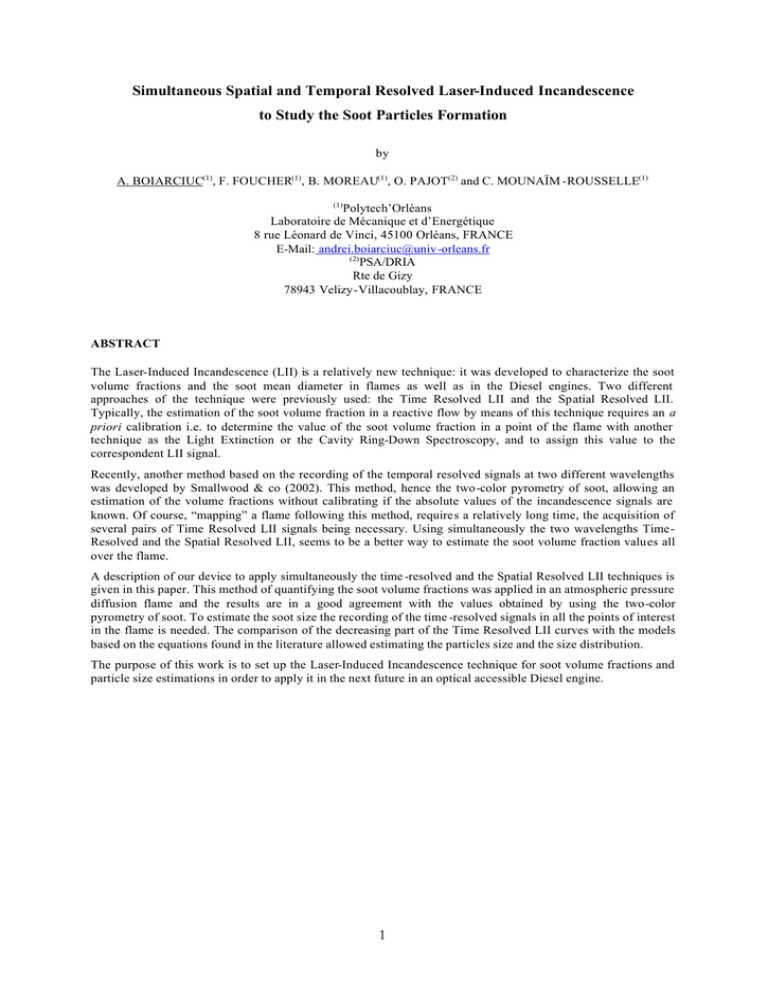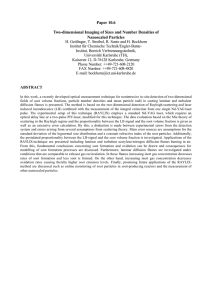Simultaneous Spatial and Temporal Resolved Laser-Induced Incandescence
advertisement

Simultaneous Spatial and Temporal Resolved Laser-Induced Incandescence to Study the Soot Particles Formation by A. BOIARCIUC(1), F. FOUCHER(1), B. MOREAU(1), O. PAJOT(2) and C. MOUNAÏM -ROUSSELLE(1) (1) Polytech’Orléans Laboratoire de Mécanique et d’Energétique 8 rue Léonard de Vinci, 45100 Orléans, FRANCE E-Mail: andrei.boiarciuc@univ-orleans.fr (2) PSA/DRIA Rte de Gizy 78943 Velizy-Villacoublay, FRANCE ABSTRACT The Laser-Induced Incandescence (LII) is a relatively new technique: it was developed to characterize the soot volume fractions and the soot mean diameter in flames as well as in the Diesel engines. Two different approaches of the technique were previously used: the Time Resolved LII and the Spatial Resolved LII. Typically, the estimation of the soot volume fraction in a reactive flow by means of this technique requires an a priori calibration i.e. to determine the value of the soot volume fraction in a point of the flame with another technique as the Light Extinction or the Cavity Ring-Down Spectroscopy, and to assign this value to the correspondent LII signal. Recently, another method based on the recording of the temporal resolved signals at two different wavelengths was developed by Smallwood & co (2002). This method, hence the two-color pyrometry of soot, allowing an estimation of the volume fractions without calibrating if the absolute values of the incandescence signals are known. Of course, “mapping” a flame following this method, requires a relatively long time, the acquisition of several pairs of Time Resolved LII signals being necessary. Using simultaneously the two wavelengths TimeResolved and the Spatial Resolved LII, seems to be a better way to estimate the soot volume fraction values all over the flame. A description of our device to apply simultaneously the time -resolved and the Spatial Resolved LII techniques is given in this paper. This method of quantifying the soot volume fractions was applied in an atmospheric pressure diffusion flame and the results are in a good agreement with the values obtained by using the two-color pyrometry of soot. To estimate the soot size the recording of the time -resolved signals in all the points of interest in the flame is needed. The comparison of the decreasing part of the Time Resolved LII curves with the models based on the equations found in the literature allowed estimating the particles size and the size distribution. The purpose of this work is to set up the Laser-Induced Incandescence technique for soot volume fractions and particle size estimations in order to apply it in the next future in an optical accessible Diesel engine. 1 1. INTRODUCTION Lately, the pollution of the environment became more and more responsible of the several diseases specific to the people living in the urban areas, the carbonaceous particles being particularly responsible of the increasing risk of lung cancer. As known, the Diesel engines are producing a great amount of the particulate matter, this being the reason for the automotive manufacturers to conduct researches for reducing this pollutant specific to the urban area. In terms of soot volume fraction the direct injection Diesel engines are less polluting than the indirect injection ones, but, the high pressure common-rail Diesel engines could be more responsible of cardiopulmonary diseases because they produce smaller primary particles. So, before developing the “clean” internal combustion engines, strategies of pollutant level measurement have to be developed. The quantification of the soot particles is necessary for a better understanding of the soot formation which is one of the processes to study during the development of the new Diesel engines that have to face the latest pollution norms, but also to validate the models of the combustion processes. In the latest years, a few non-intrusive, insitu, laser techniques have been set-up to quantify the soot and to study the soot formation in flames and inside the cylinder of Diesel engines. Among those techniques, the light extinction (Choi et al., 1995, Axelsson et al. 2001), the Cavity Ring-Down Spectroscopy, (Schoemaecker-Moreau 2001), the light scattering (Vaglieco et al., 2002) and the Laser-Induced Incandescence (Smallwood et al. 2002, Kock and Roth 2003) were used on a large scale for the soot volume fractions determination and the soot particle sizing. The advantage of the Laser-Induced Incandescence over all these techniques is that it allows determining both the soot volume fractions and the soot size. This technique was applied in different media: in atmospheric pressure flames, in high pressurized flames (Hofmann et al. 2001), in shock tubes (Starke and Roth 2002) and in Diesel engines (Dec 1997, Kock and Roth 2003). 2. LASER-INDUCED INCANDESCENCE THEORY AND EXPERIMENTAL APPROACHES The Laser-Induced Incandescence (LII) technique is based on recording of the black-body radiation of the soot when irradiated with a pulsed laser beam or sheet of sufficiently high energy, the soot being heated up to the vaporization temperature. The soot incandescence signal recorded with a photomultiplier tube has a rising part during a few nanoseconds (practically as long as the laser pulse duration) and a decreasing part of a few hundred nanoseconds of duration. The incandescence signal is the image of the heating and respectively of the cooling of the soot particles located in the measurement volume. The intensity is proportional to the soot volume fraction (Melton 1984) and the shape of the decreasing part is in direct relationship with the irradiated soot mean diameter, hence, the larger the particle size, the slower their cooling. Figure 1 Energy exchange during the LII process After the laser heating, the soot particles exchange energy to the environment, the main processes being the heat conduction, the vaporization and the thermal radiation, as it is schematized in Figure 1. The equation describing the energy exchange (Eq.1) was firstly modeled by Melton (1984) and it is, actually, the basis of the particles sizing by means of LII. 2 qabsorption = qvaporization + qheat _ conduction + qradiation + q particle _ heating (Eq.1) The terms of the equation written above are respectively: the laser energy absorption, the particle vaporization, the heat conduction to the environment, the thermal radiation and the internal heating of the particle. By an analysis of the modeled energy exchanges during the LII phenomenon, (Schraml et al. 2000) showed that the dominant heat loss after the laser pulse is due to the vaporization, the second part of the process being dominated by the heat conduction. The radiation losses were quantified to be insignificant compared to the other two heat loss processes. Recently, a more thorough model of the energy balance takes into account the energy produced by the particle annealing and the energy produced by oxidation (Michelsen 2003). A simplification of the particles heat exchange model available only in the conditions of a low energy fluence excitation was proposed by Snelling et al (2004), in this case the vaporization term of the energy balance being neglected. Whatever the form of the terms of the equation 1, the principle of the soot particle sizing remains the same: a fit of the modeled LII signal on the recorded one allows to determine a primary particle mean diameter, if the assumption of spherical primary particles is made. This technique can be successfully used for both particle sizing and volume fraction estimations. Basically, two experimental approaches were developed: the Time Resolved Laser Induced Incandescence (TIRE LII) and the Spatial (or 2D) Resolved Laser Induced Incandescence (2D LII). In the first case the evolution of the particle incandescence signal versus time is recorded by means of a photomultiplier tube, this being the commonly used method for soot sizing, but an estimation of the soot volume fraction is also possible if one makes a calibration in order to determine the ratio factor between the LII signal and the actual soot concentration. Recording the incandescence signal during a relatively short period of time by means of Intensified CCD camera, is the basis of the second approach of the LII technique. The intensity in the gray levels is then proportional to the soot volume fraction, but a calibration is needed also. Usually, the calibration of the LII signal as function of the volume fraction is made with the light extinction technique. Smallwood et al. (2002) developed a new methodology so-called “self-calibration” technique: the LII signal is acquired at two different wavelengths to estimate the soot temperature after the laser heating and then to calculate the soot volume fraction from one of the acquired signals. It only needs to calibrate the receiving optics and detectors with a steady known temperature source. A calibration factor ?(?) , i.e. the ratio between the recorded signal, S CAL (V) and the spectral radiance of the lamp source at the recording wavelength R(?,T) (W/m3 Sr) must be determined: η( λ ) = SCAL R( λ ,T ) (Eq.2) Assuming that the calibration factor has the same relationship with the experimental LII signal, LII_e(?) at the detection wavelength ? and the spectral radiance of the particles, Rp (?,T), one can express the Rp(?,T) as (Smallwood et al. 2002): Rp ( λ ,T ) = LII _ e η( λ ) (Eq.3) −1 d p2 LII _ e(λ ) 2π 2c 2h khcλT 3 = wb e − 1 E( m) ∫d p1 N p d p f (d p ) dd p 6 η( λ ) λ (Eq.4) where wb is the width of the laser sheet, c the light velocity, h the Planck constant, k the Boltzmann constant, T the particle temperature, E(m) the complex refraction index function of the soot, Np the number of particles in the measurement volume , d p the diameter of a particle (assuming sphericity of the particles) and, finally, f(dp ) the particles size distribution function. The right hand term of the Eq.4 is the theoretical expression of the particles radiance in a solid angle of 4p sterradians. The calibration factor takes into account the collection efficiency, including the collection solid angle, then further corrections are not necessary. Assuming that: hc hc e kλT −1 ≈ e k λT One can express the theoretical soot heated temperature as: 3 (Eq.5) T= hc 1 1 1 − k λ2 λ1 LII _ e (λ1 ) η (λ2 ) λ16 E( m) 2 log 6 LII _ e(λ2 ) η ( λ1 ) λ2 E( m)1 (Eq.6) The theoretical expression of the soot volume fraction in the measurement volume is: d p2 N pπ d p 3 d p1 6 fv = ∫ f ( d p )dd p (Eq.7) Or, having the temperature and the LII signal expressed in absolute spectral units, one can calculate the soot volume fraction as (Smallwood et al. 2002): fv = khcλT LII _ e(λ ) λ6 e −1 η( λ ) wb 12π c 2hE ( m) (Eq.8) Recording the LII signals at two detection wavelengths for a relatively small measurement volume is a solution to determine the soot volume fraction with a good spatial resolution, but plotting the soot profiles in a flame with this method takes a long time. So, our solution to provide several soot profiles in a shorter period of time is to combine simultaneously both TIRE and 2D LII. The application of this approach is simple: the soot particles in the flame are heated by a laser sheet, so we record TIRE-LII signal at two different wavelengths, in a small measurement volume and the image of the 2D LII signal. A correlation between the relative intensities of the 2D LII image and the effective soot volume fraction determined by the self-calibrating method of TIRE LII in a known point of this image allows to “map” the soot concentrations in a volume obtained as an intersection of the laser sheet and the flame. 3. EXPERIMENTAL SET-UP The study was carried out with the experimental set-up shown in Figure 2. The excitation source is a Nd:YAG laser operating at 10 Hz with maximum energy per pulse of 400 mJ at the fundamental wavelength of 1064 nm. The FWHM of the pulse is around 10 ns and the unfocused beam diameter is around 10 mm. The laser beam is diverged by a cylindrical lens and then filtered trough a slit in order to obtain a laser sheet of a rectangular section and an energy profile as uniform as possible. After passing through the flame, the average of the laser energy is recorded by a power-meter. The dimensions of the cross-section of the laser sheet in the flame surface were measured with a photodiode placed behind a 10 µm diameter pin-hole. Besides of the laser sheet crosssection dimensions this measurement allows to plot an energy distribution as displayed in Figure 3. The local maximum energy across the laser sheet varies within a 20% interval. In the Laser-Induced Incandescence technique, the optimum excitation conditions are often analyzed by means of the energy fluence curves, i.e. the plot of the integrated LII signal versus the laser fluence expressed in J/cm2 . For our experimental conditions, we can observe in Figure 4, that the integrated LII signal evolution is almost constant for laser fluence values situated between 0.09 and 0.15 J/cm2 , this evolution being in a good agreement with the literature (Vander Wal and Jensen 1998). Finally, the value of the excitation laser fluence chosen was fixed around 0.15 J/cm2 (the averaged value over the laser sheet section of a 0.8 mm width and 14.8 mm height). To optimize our methodology, we first performed experiments with an atmospheric pressure isooctane-air diffusion flame issued from a burner described by Olson et al. (1985). Basically, the burner is like an oil lamp: the fuel is supplied by means of cotton wick immerged in the liquid fuel and the air co-flow is supplied by a turbine through a sintered plate and a honeycomb plate. The air flow rate was set at 2.35 g/s, corresponding to an estimated velocity of 13 cm/s at the exit of the honeycomb plate and the combustible consumption was around 16x10-6 g/s. The visible height of the flame obtained was about 35 mm, as described in the reference. 4 Figure 2 Experimental set-up 50 650 nm 405 nm Integrated LII signal [a.u.] Normalized energy [% of max] 110 1.5 0 40 30 20 10 0 0.05 14 Height [mm] 0 Width [mm] Figure 3 Energy distribution across the laser sheet 5 0.1 0.15 0.2 Laser fluence [J/cm2 ] 0.25 Figure 4 Laser fluence curves 0.3 Recording simultaneously the soot incandescence temporal evolution at two wavelengths and the 2D signal induced by the same laser pulse is one of the objectives of our study. This is realized by placing a detection unit including the two photomultipliers on one side of the laser sheet, and an ICCD camera on the other side, as shown in the Figure 2. For both configurations, the detection axis is perpendicular to the laser sheet. The temporal evolution of the LII signal is recorded with two photomultipliers Hamamatsu 7710-11, having a rising time of 1.4 ns and a good spectral response in the visible domain. The signal recorded by photomultipliers is focused by an objective, split by a beam-splitter and filtered with bandwidth filters centered at 650 and 405 nm respectively (with a FWHM of 10 nm). As the focusing objective has a pinhole, the measurement volume in the flame is a cylinder with an estimated diameter of 1 mm and a height equal to the laser sheet width. The ICCD camera is placed on the other side of the laser sheet with a filter centered at 460 nm (FWHM of 50 nm) mounted on the objective. The LII temporal signals are acquired with 8 bit resolution acquisition system with a sample rate of 1 GS/s. Due to the camera acquisition rate of 4 Hz, an electronic device was designed to trig simultaneously the acquisition for all of the detection devices at every fifth laser shot. For the image, the acquisition delay was set to 50 ns after the laser pulse and the gate width to 20 ns. The delay avoids the interference with fluorescence of some molecules such as of C2 , but it should be as short as possible to have a sufficient signal/noise ratio and to avoid the particles size effects on the signal. An example of the temporal signals and images obtained is presented in Figure 5. Laser sheet Figure 5 Simultaneous 2D and Time Resolved LII One of the most important parts of our experiments is the calibration of the detection optics. It was realized with a calibrated tungsten ribbon lamp at a steady temperature of 2705 K. The spectral radiance as a function of wavelength is communicated for this temperature in the lamp’s specifications. The calibration consists in recording the radiance of the lamp with the photomultipliers through the optics situated on the optical path e.g. the filters and the beam-splitter and to calculate a calibration factor that is, in fact, the ratio between the output signal of the photomultiplier and the communicated absolute radiance of the lamp at the correspondent wavelength (Eq.2). 6 4. RESULTS AND DISCUTION The soot volume fraction was firstly calculated for several points situated in the median plane of the flame at 15 and 20 mm height above burner (HAB), having as input data the maximum of the TIRE LI I signals as well as the previously determined calibration factors. The soot profiles obtained are represented in the Figures 6 and 7 with blue squares, and are the average of 64 acquisitions. Non-symmetry of the soot profiles obtained with this method is obvious. The non-symmetrical repartition of the estimated soot volume fraction is certainly due the occurrence of two phenomena: the flame can be not perfectly symmetric with respect to a central axis and in certain regions of the laser sheet an extinction of the laser intensity by soot itself can be observed. In almost similar flame conditions the reference (Olson et al. 1985) communicates a maximum value of soot volume fraction of 4.3 ppm, value estimated by means of the light extinction technique. This value is in fact integrated over the path of the laser beam in the flame, named in the above mentioned reference “line-of-sight” soot volume fraction. Since in this study local values of soot volume fraction were determined, it seemed interesting to us to evaluate the average of the soot concentration at the investigated heights above burner. Whilst our average value of soot volume fraction at 20 mm HAB of 4.59 ppm is not very far of that provided in the reference, the mean value obtained after integrating the soot profile at 15 mm HAB is of 6.5 ppm. An explanation of this difference can be that an over estimation of the soot volume fraction can be induced by the bending of the flame, as well as by small differences in reproducing the flame conditions. 1.0E-005 S oot volume fraction [m 3 soot/m 3 gas] S oot volume fraction [m 3 soot/m 3 gas] 2.0E-005 Soot profile LII 2D Soot profile TR LII 1.6E-005 1.2E-005 8.0E-006 4.0E-006 0.0E+000 Soot profile LII 2D Soot profile TR LII 8.0E-006 6.0E-006 4.0E-006 2.0E-006 0.0E+000 0 2 4 x [mm] 6 0 Figure 6 Soot profile at 15 mm HAB 2 4 x [mm] 6 Figure 7 Soot profiles at 20 mm HAB The 2D LII gives information about the relative soot volume fraction in the intersection between the laser sheet and the flame. The distribution of the soot concentration together with the absolute soot volume fraction in one point allows to estimate finally the absolute soot concentration all over the measurement volume, so all over the recorded image (basic principle shown in Figure 5). After recording the 2D LII images the relative soot distribution profiles can be converted in absolute soot volume fraction distribution if the value of the soot distribution in one point of the flame is known. The soot volume fraction obtained in that manner for heights above burner of 15 and 20 mm is plotted with solid red line on Figures 6 and 7, respectively. The agreement between the values estimated by means of the TIRE LII (blue squares) and the values estimated by simultaneous TIRE and 2D LII (red curves) is quite good. However, the non-symmetry of the profiles, due probably to a nonsymmetry of the flame as well as an extinction of the laser sheet in certain regions is still present. A quite important difference between the soot volume fraction values estimated by the two methods in the left region of the flame at 15 mm HAB can be observed, a possible reason being the perturbation of the environment on the flame. Indeed, the acquisition of the TIRE LII signals of a soot profile takes more than one hour and during this time, the flame can be perturbed because of the environment. The decreasing part of the recorded temporal LII signal is useful for sizing the soot particles situated in the measurement volume if one fits a modeled curve on the acquired curve. The model of the LII process is based on the energy balance (Eq. 1) and the mass conservation of the soot primary particles. The developed form of the Eq. 1, for a single soot particle is (Smallwood et al 2001): 7 2 ∆H V (T ) dM 2k g ( T − Tg )π d p 1 dT Ca q = − + + qr + π d p3 ρs cs M V (T ) dT (d p + G(α ) λMFP ) 6 dt (Eq. 9) with Ca the soot absorption cross section, q the laser fluence, ? HV the soot heat of vaporization, MV the molecular weight of the soot as a function of temperature T, k g the heat conduction coefficient of the environmental gas, G a heat transfer coefficient depending on the thermal accommodation coefficient a, ?MFP the mean free path of the gas, q r the radiation term, ?s the density of the soot and cs the specific heat of the soot. Several assumptions were made in the model: the particles are spherical, their diameters in the measurement volume are log-normally distributed and the vaporisation occurs from the exterior of the particles. The difficulty of choosing the right coefficients is one of the problems when sizing particles with the LII technique, the errors can be induced mainly by two factors: the thermal accommodation coefficient in the expression of the heat transfer, a, and the complex refraction index function of the soot, E(m). For the first one we have chosen the value of 0.26 communicated by Smallwood et al. (2002). The second one was considered as a linear function of wavelength fitted on the values provided by Krishnan et al. (2001). An example of curve fitting for the signals acquired at 20 mm HAB is presented in the Figure 8. The best fit in this case was obtained for a mean particle diameter of 26 nm and a standard deviation of 1.32, assuming a lognormal repartition of the particle diameters in the measurement volume. 1.0 Experimental LII signal Modeled LII signal Normalized LII [a.u.] 0.8 0.6 0.4 0.2 0.0 0 200 400 600 Time [ns] Figure 8 LII curves fit example Figure 9 Image of soot sampled at 20 mm HAB Soot have been sampled in several points of the flame in order to carry out a study regarding the particles size distribution, a picture of a soot chain sampled at 20 mm HABM, obtained by TEM is presented in the Figure 9. As one can observe from this picture, the size of the soot is distributed in a large interval, the “diameters” going up to 40 nm. However, a more thorough study will be done in the next future. 5. CONCLUSIONS AND PERSPECTIVES The Laser-Induced Incandescence technique for soot quantifying was set up. A new approach to quantify the soot volume fractions based on both two-color soot pyrometry and 2D LII was presented. The simultaneous acquisition of a Time Resolved LII signal at two wavelengths and Spatial Resolved signal allowed us to “map” the soot volume fractions in an atmospheric pressure diffusion flame in a relatively short time and with a good spatial resolution. The method seems to be well since a good agreement was found between the soot concentration values estimated by the two color pyrometry and our approach of the technique. However, the calibration of the receiving optics is of an outmo st importance. In order to succeed in the technique of the 8 simultaneous detection of the Time Resolved and 2D LII, a uniform energy distribution across the laser sheet is imperative. A first estimate of the soot mean diameter at 20 mm HAB in our flame was also done. The soot sizing was performed with the assumption of a log-normal primary particle size distribution. A study of particle size distribution by termophoretical sampling will be done in the next future in order to verify the values issued from the LII models. The application of the LII technique in the cylinder of an optical accessible Diesel engine is the final objective of this study. ACKNOWLEDGEMENTS The authors want to thank to Julien Sotton for his help in the 2D images experiments. REFERENCES Axelsson B., Collin R., Bengtsson P. E. (2001). Laser-Induced Incandescence for soot particle size and volume fraction measurements using on-line extinction calibration, Applied Physics B, 72, 367-372, 2001 Choi M. Y., Mulholland G. W., Hamins A., Kashiwagi T. (1995). Comparison of the Soot Volume Fraction Using Gravimetric and Light Extinction Techniques. Combustion and Flame 102:161-169, 1995 Dec J. E. (1997). A Conceptual Model of DI Diesel Combustion Based on Laser-Sheet Imaging SAE Paper 970873 Hofmann M., Bessler W.G., Schulz C., Jader H. (2002). Laser Induced Incandescence for Soot Diagnostics at High Pressures, Applied Optics, 2002 Kock B.F., Roth P. (2003). Two-Color TR-LII Applied to In-Cylinder Diesel Particle Sizing, European Combustion Meeting, Orléans, France 2003 Krishnan S.S., Lin K.C., Faeth G.M. (2001). Extinction and Scattering Properties of Soot Emitted From Buoyant Turbulent Diffusion Flames, Journal of Heat Transfer, April 2001 vol. 123, pages 331-339 Melton L.A. (1984). Soot Diagnostics Based on Laser Heating, Applied Optics 23, 2201-2208, 1984 Michelsen, H.A.(2003). Understanding and predicting the temporal response of laser-induced incandescence from carbonaceous particles, Journal of Chemical Physics, volume 118, number 15, 2003 Ols on, D.B., Pickens, J.C., Gill R.J., (1985). The Effects of Molecular Structure on Soot Formation II. Diffusion Flames Combustion and Flame, 62: 43-60 (1985) Schraml, S., Dankers, S., Bader, K., Will, S., Leiperz, A. (2000). Soot Temperature Measurements and Implications for Time Resolved Laser Induced Incandescence (TIRE LII), Combustion and Flame, 120:439-450 (2000) Smallwood G. J., Snelling D.R., Liu F., Gülder Ö. L. (2001). Clouds Over Soot Evaporation: Errors in Modeling Laser-Induced Incandescence of Soot, Journal of Heat Transfer, august 2001, vol 123, pages 814-818 Smallwood G, Clavel D., Gareau D., Sawchuk R., Snelling D., Witze P., Axelsson B., Bachalo W., Gülder Ö. (2002). Concurrent Quantitative Laser-Induced Incandescence and SMPS Measurements of EGR Effects on Particulate Emissions from a TDI Diesel Engine, SAE 2002-01-2715 Snelling D. R., Liu F., Smallwood G.J., Gülder Ö.L. (2004). Determination of the soot absorption function and thermal accomodation coefficient using low-fluence LII in a laminar coflow ethylene diffusion flame, Combustion and Flame, 136:180-190, 2004 Starke R., Roth P. (2002). Soot Particle Sizing by LII During Shock Tube Pyrolysis of C6H6, Combustion and Flame, 127:2278-2285 (2002) Schoemaecker-Moreau C. (2002). Diagnostics Laser dans une flamme de diffusion : imagerie quantitative de nanoparticules de suies et d’espèces majoritaires et minoritaires, Université des Sciences et Technologies de Lille, (2002) Vaglieco B.M., Merola, S., D’Anna A., D’Alessio A, (2002). Spectroscopic analysis and modeling of particulate formation in a diesel engine, Journal of Quantitative Spectroscopy & Radiative Trasfer 73 (2002) 443-450 Vander Wal, R.L., Jensen K.A. (1998). Laser-induced incandescence: excitation intensity, Applied Optics, Vol. 37, No. 9, pages 1607-1616 9







